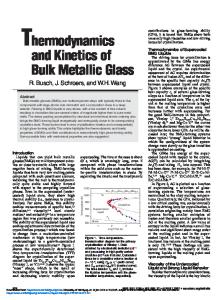Bulk Glass-Forming Metallic Alloys: Science and Technology
- PDF / 5,362,281 Bytes
- 15 Pages / 604.8 x 806.4 pts Page_size
- 55 Downloads / 340 Views
Introduction The development of bulk glass-forming metallic alloys has led to interesting advances in the science of liquid metals. This article begins with brief remarks about the history and background of the field, then follows with a discussion of multicomponent glass-forming alloys and deep eutectics, the chemical constitution of these new alloys, and how they differ from metallic glasses of a decade ago or earlier. Recent studies of deeply undercooled liquid alloys and the insights made possible by their exceptional stability with respect to crystallization will then be discussed. Advances in this area will be illustrated by several examples. The article then describes some of the physical and specific mechanical properties of bulk metallic glasses (BMGs), and concludes with some interesting potential applications.
Historical Background and Development of Bulk Metallic Glasses The first liquid-metal alloy vitrified by cooling from the molten state to the glass transition was Au-Si, as reported by 42
Duwez at Caltech in I960.1 Duwez made this discovery as a result of developing rapid quenching techniques for chilling metallic liquids at very high rates of 105-106 K/s. The work of Turnbull and his group in the early 1960s was another critical contribution to the subject. This work illustrated the similarities among metallic glasses, ceramic glasses, silicates, and so on. Specifically, Turnbull, Chen, a n d other later collaborators 2 - 3 clearly demonstrated the existence of a glass transition in rapidly quenched Au-Si glasses as well as other Pd-Si and Pd-Cu-Si glass-forming alloys synthesized initially by the Duwez group. Earlier, Turnbull had predicted that as the ratio of the glass-transition temperature to the melting point, or liquidus temperature, of an alloy (referred to as the reduced glass-transition temperature t rg ) increased from values near 1/2 to values near 2/3, the homogeneous nucleation of crystals in the undercooled melt should become very sluggish on laboratory time scales. 4 Work on the Au-Si, Pd-Si, and Pd-Cu-Si alloys confirmed this prediction. This "Turnbull" criterion for the suppression of crystallization in undercooled melts remains today one of the best "rules of thumb" for predicting the glass-forming ability of any liquid. The field of metallic glasses gained m o m e n t u m in the early 1970s w h e n researchers at Allied Chemical Corporation developed continuous casting processes for commercial manufacture of metallic-glass ribbons and sheets. 5 During the same period, Chen (then at Bell Laboratories) a n d collaborators used simple suction-casting methods to form millimeter-diameter rods of ternary Pd-Cu-Si alloys at significantly lower
cooling rates in the range of 103 K/s. 6 If one arbitrarily defines the millimeter scale as "bulk," then these ternary glasses were perhaps the first examples of "bulk" metallic glasses. B e g i n n i n g in 1982,' T u r n b u l l , D r e h m a n , Kui, Greer, and other collaborators 7,8 carried out experim e n t s on P d - N i - P alloy melt
Data Loading...











